The Phase Diagram of a CaO-Al2O3-VOx Slag System under Argon Atmosphere at 1500 °C
Abstract
1. Introduction
2. Experimental Procedure
3. Phase Equilibria of the CaO-Al2O3-VOx System under Argon Atmosphere at 1500 °C
3.1. Experimental Results
3.2. The 1500 °C Iso-Thermal Phase Diagram of the CaO-Al2O3-VOx System
4. Conclusions
Author Contributions
Funding
Data Availability Statement
Conflicts of Interest
References
- Kumar, R.R.; Gupta, R.K.; Sadhasivam, M.; Pradeep, K.; Prasad, M. Mechanical behaviour and interface correlative microscopic analysis of vacuum diffusion bonded dissimilar stainless steel/α-Ti alloy joint for aerospace applications. Vacuum 2023, 217, 112561. [Google Scholar] [CrossRef]
- Murugesan, V.; Govindarasu, M.; Manoharadas, S.; Pandiaraj, S.; Thiruvengadam, M.; Govindasamy, R.; Vaiyapuri, M. Combinatorial anticancer effects of multi metal ion and drug substitute with hydroxyapatite coatings on surgical grade 316LSS stainless steel alloys towards biomedical applications. J. Mater. Res. Technol. 2023, 27, 7244–7258. [Google Scholar] [CrossRef]
- Wang, Y.; Meng, W.; Hu, X.; Yao, Y.; Wang, H. Reduction and reconstruction of vanadium-containing steel slag at high temperature. J. Environ. Chem. Eng. 2023, 11, 111320. [Google Scholar] [CrossRef]
- Yücel, O.; Cinar, F.; Addemir, O.; Tekin, A. The Preparation of Ferroboron and Ferrovanadium by Aluminothermic Reduction. High Temp. Mater. Process. 1996, 15, 103–110. [Google Scholar] [CrossRef]
- Zhou, Y.; Wang, Y.; Chou, K. Synthesis of high-quality ferrovanadium nitride by carbothermal reduction nitridation method. J. Iron Steel Res. Int. 2021, 28, 255–262. [Google Scholar] [CrossRef]
- Wang, W. Study on the Process of Vanadium Containing Steel Smelting by Direct Alloying with V2O5 Self-Reduction. Ph.D. Thesis, Wuhan University of Science and Technology, Wuhan, China, 2013. [Google Scholar]
- Xiao, Y.; Jalkanen, H.; Yang, Y.; Mambote, C.R.; Boom, R. Ferrovanadium production from petroleum fly ash and BOF flue dust. Miner. Eng. 2010, 23, 1155–1157. [Google Scholar] [CrossRef]
- Wang, C.; Tian, X.; He, R.; Zhang, J.; Shi, C.; Zhang, D. Study on the technology of V2O5 direct alloying. Sichaun Metall. 2015, 37, 26–30. [Google Scholar] [CrossRef]
- Ding, Z. Study on the production of vanadium containing steel by direct alloying of V2O5. Hebei Metall. 2021, 1, 51–54. [Google Scholar] [CrossRef]
- Dai, M. Study on Direct Alloying of Vanadium Oxides for Smelting Untempered Steel. Ph.D. Thesis, Wuhan University of Science and Technology, Wuhan, China, 2015. [Google Scholar]
- Moskalyk, R.R.; Alfantazi, A.M. Processing of vanadium: A review. Miner. Eng. 2003, 16, 793–805. [Google Scholar] [CrossRef]
- Xiong, Y.; Wang, L.; Wang, L.; Li, S.; Yang, G.; Cao, C.; Liu, S.; Nie, Y.; Jia, L. Optimization and kinetic analysis of direct acid leaching of vanadium from converter vanadium slag under atmospheric pressure. Miner. Eng. 2023, 198, 108091. [Google Scholar] [CrossRef]
- Jiang, H.; Yu, C.; Sun, S.; Zhen, T. Tungsten, molybdenum, vanadium oxide direct alloying production of M2 high speed steel. J. Chongqiang Univ. 2002, 25, 76–79. [Google Scholar] [CrossRef]
- Rovnushkin, V.A.; Toprishchev, G.A.; Rakavaskii, F.S. Mechanisms of direct alloying of steel with vanadium. Steel USSR 1979, 10, 11–14. [Google Scholar]
- Zhou, Y.; Li, Z. Theory and technology of smelting high speed steel by direct alloying of tungsten, molybdenum and vanadium oxide ore. China Tungsten Ind. 2006, 21, 13–18. [Google Scholar] [CrossRef]
- Yu, Y. Principle of Metallurgy; Metallurgical Industry Press: Beijing, China, 2020; p. 453. [Google Scholar]
- Hallstedl, B. Assessment of the CaO-Al2O3 System. J. Am. Ceram. Soc. 1990, 73, 15–23. [Google Scholar] [CrossRef]
- Jerebtsov, D.A.; Mikhailov, G.G. Phase diagram of CaO-Al2O3 system. Ceram. Int. 2001, 27, 25–28. [Google Scholar] [CrossRef]
- Eriksson, G.; Pelton, A.D. Critical evaluation and optimization of the thermodynamic properties and phase diagrams of the CaO-Al2O3, Al2O3-SiO2, and CaO-Al2O3-SiO2 systems. Metall. Trans. B 1993, 24, 807–816. [Google Scholar] [CrossRef]
- Pezzin, R.d.O.; Berger, A.P.L.; Grillo, F.F.; Junca, E.; Furtado, H.S.; de Oliveira, J.R. Analysis of the influence of the solid and glass phases on steel desulfurization with slags from the CaO–Al2O3 systems using computational thermodynamics. J. Mater. Res. Technol. 2020, 9, 838–846. [Google Scholar] [CrossRef]
- Li, X.; Xie, W.; Wang, N.; Qiao, Z.; Cao, Z. Thermodynamic optimization of Al2O3-V2O5 systems. Nonferrous Met. Sci. Eng. 2019, 10, 13–18. [Google Scholar] [CrossRef]
- Dabrowska, G.; Tabero, P.M.K. Phase relations in the Al2O3-V2O5-MoO3 system in the solid state. The crystal structure of AlVO4. J. Phase Equilibria Diffus. 2009, 30, 220–229. [Google Scholar] [CrossRef]
- Walczak, J.; Tabero, P. Studies on the system Al2O3-V2O5-MoO3. J. Therm. Anal. 1990, 36, 2173–2176. [Google Scholar] [CrossRef]
- Kurzawa, M.; Dabrowska, G. Phase Relations in The System Al2(MoO4)3–V2O5. J. Therm. Anal. Calorim. 2000, 60, 183–186. [Google Scholar] [CrossRef]
- Cao, Z.; Wang, N.; Xie, W.; Qiao, Z.; Jung, I.-H. Critical evaluation and thermodynamic assessment of the MgO-V2O5 and CaO-V2O5 systems in air. Calphad 2017, 56, 72–79. [Google Scholar] [CrossRef]
- Qiu, J.; Jiang, J.; Xie, X.; Li, W.; Liu, C. Phase Diagram of CaO–Al2O3–V2O5 Slag System at 1500 °C and 1600 °C. J. Sustain. Metall. 2023, 9, 1010–1019. [Google Scholar] [CrossRef]
- Xiang, J.-Y.; Wang, X.; Pei, G.-S.; Huang, Q.-Y.; Lü, X.-W. Solid-state reaction of a CaO-V2O5 mixture: A fundamental study for the vanadium extraction process. Int. J. Miner. Metall. Mater. 2021, 28, 1462–1468. [Google Scholar] [CrossRef]
- Yang, Y.; Mao, H.; Malin, S. CALPHAD: Computer Coupling of Phase Diagrams and Thermochemistry Contents of volume 26. Calphad 2002, 26, 599–602. [Google Scholar] [CrossRef]
- Maltsev, V.; Janod, E. Crystallization of quasi-two-dimensional vanadates in the CaO–V2O3–VO2–V2O5 system. J. Cryst. Growth 2002, 240, 170–175. [Google Scholar] [CrossRef]
- Muan, A.; Najjar, M.S. Compositions involving V2O3-Al2O3-CaO. US, 5070065, 3 December 1991. [Google Scholar]
- Menon ESarath Kumar Krishnan, R. Phase transformations in Ti-V alloys. J. Mater. Sci. 1983, 18, 365–374. [Google Scholar] [CrossRef]
- Qing, X. Vanadium Titanium Magnetite Blast Furnace Smelting; Metallurgical Industry Press: Beijing, China, 1994; pp. 1–8. [Google Scholar]
- Available online: http://www.sinopharm.com/ (accessed on 11 December 2023).
- Liu, C.; Qiu, J.; Liu, Z. Phase Equilibria in the System CaO-SiO2-La2O3-Nb2O5 at 1400 °C. Metals 2021, 11, 1892. [Google Scholar] [CrossRef]
- Qiu, J.; Wang, H.; Huo, G.; Liu, C. Phase Equilibria of CaO-Al2O3-CeOx slag system at 1600 °C in reducing atmosphere. Ceram. Int. 2023, 19, 20447–20455. [Google Scholar] [CrossRef]
- Biesinger, M.C.; Payne, B.P.; Grosvenor, A.P.; Lau, L.W.M.; Gerson, A.R.; Smart, R.S.C. Resolving surface chemical states in XPS analysis of first row transition metals, oxides and hydroxides: Cr, Mn, Fe, Co and Ni. Appl. Surf. Sci. 2011, 257, 2717–2730. [Google Scholar] [CrossRef]
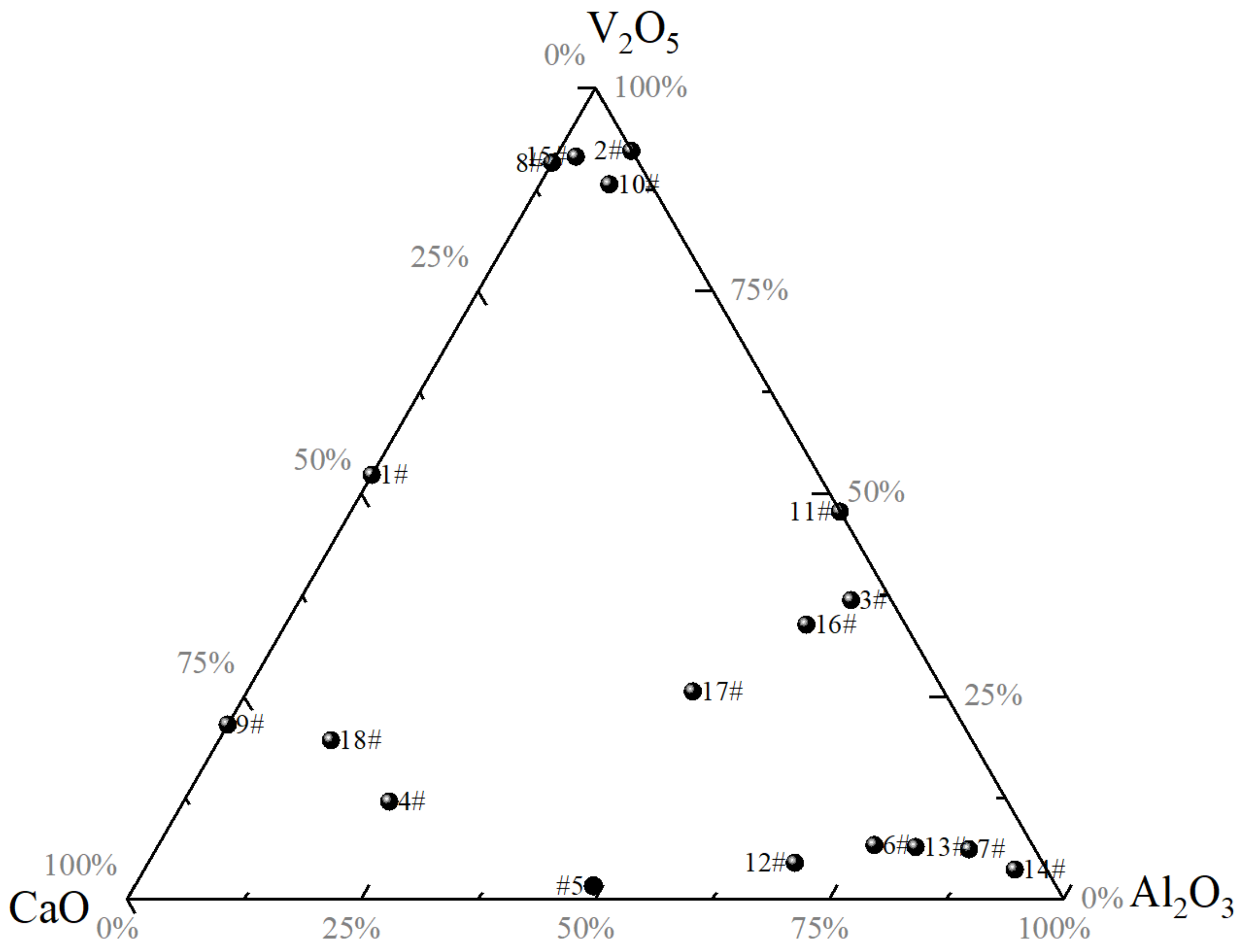
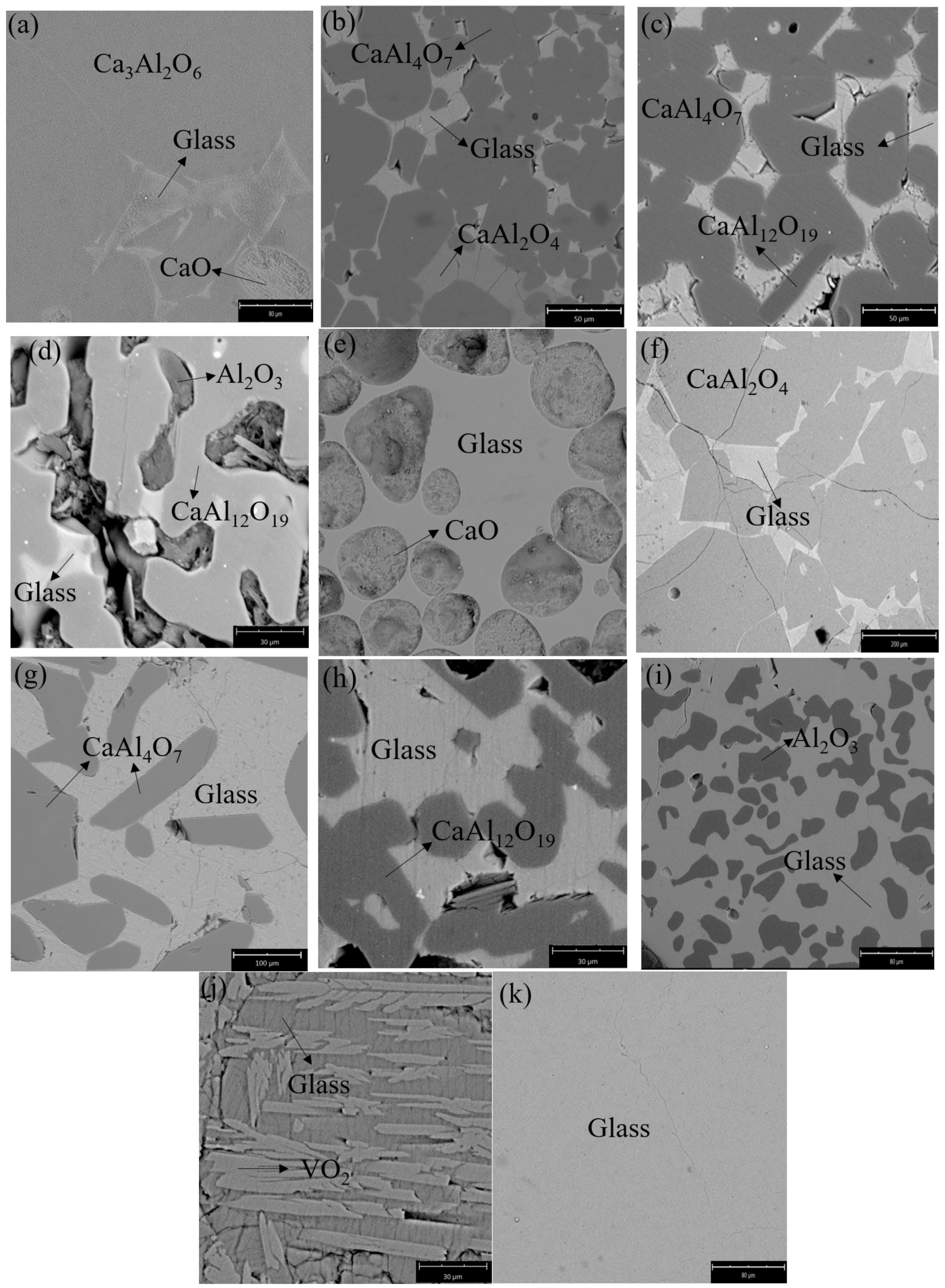
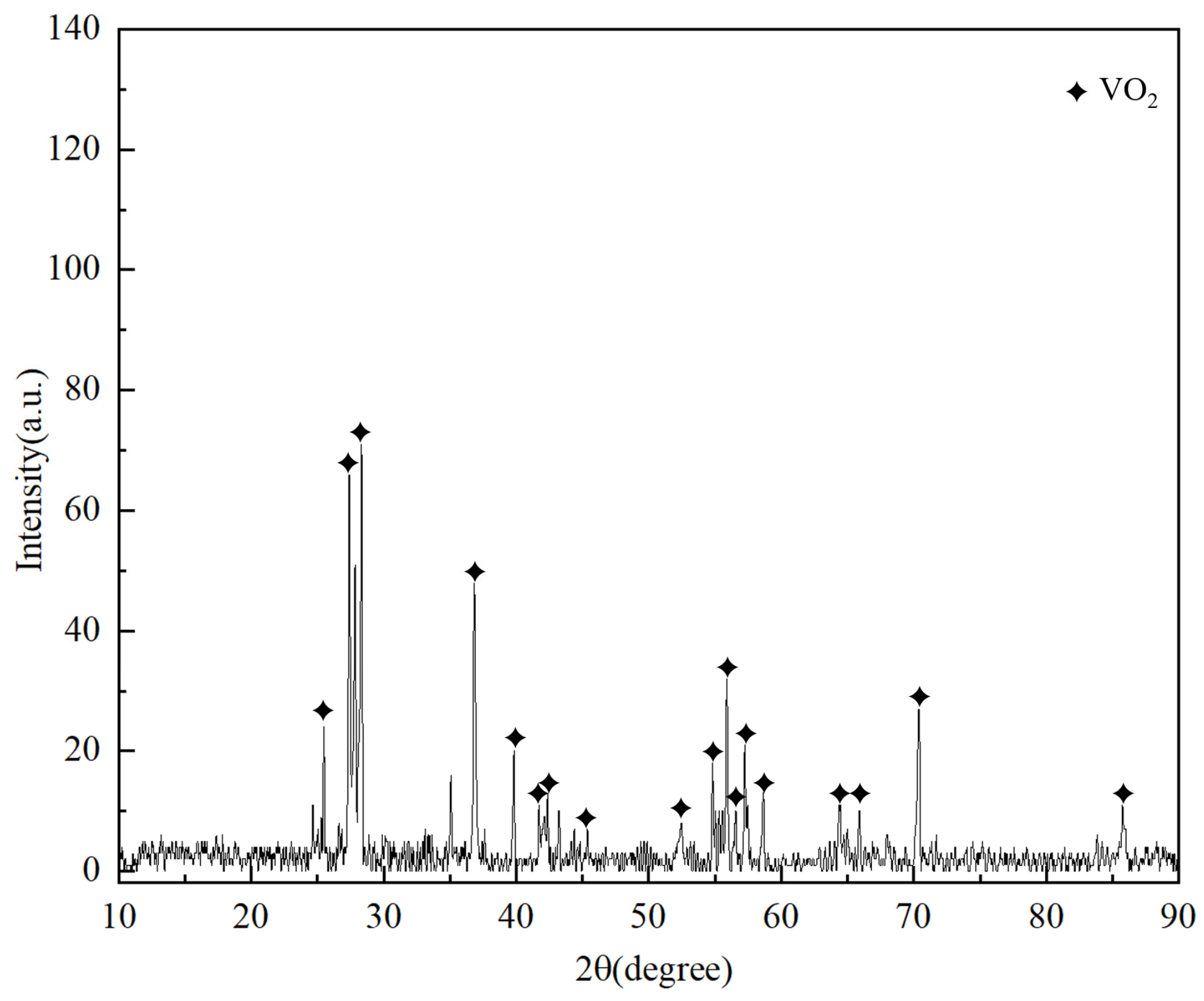
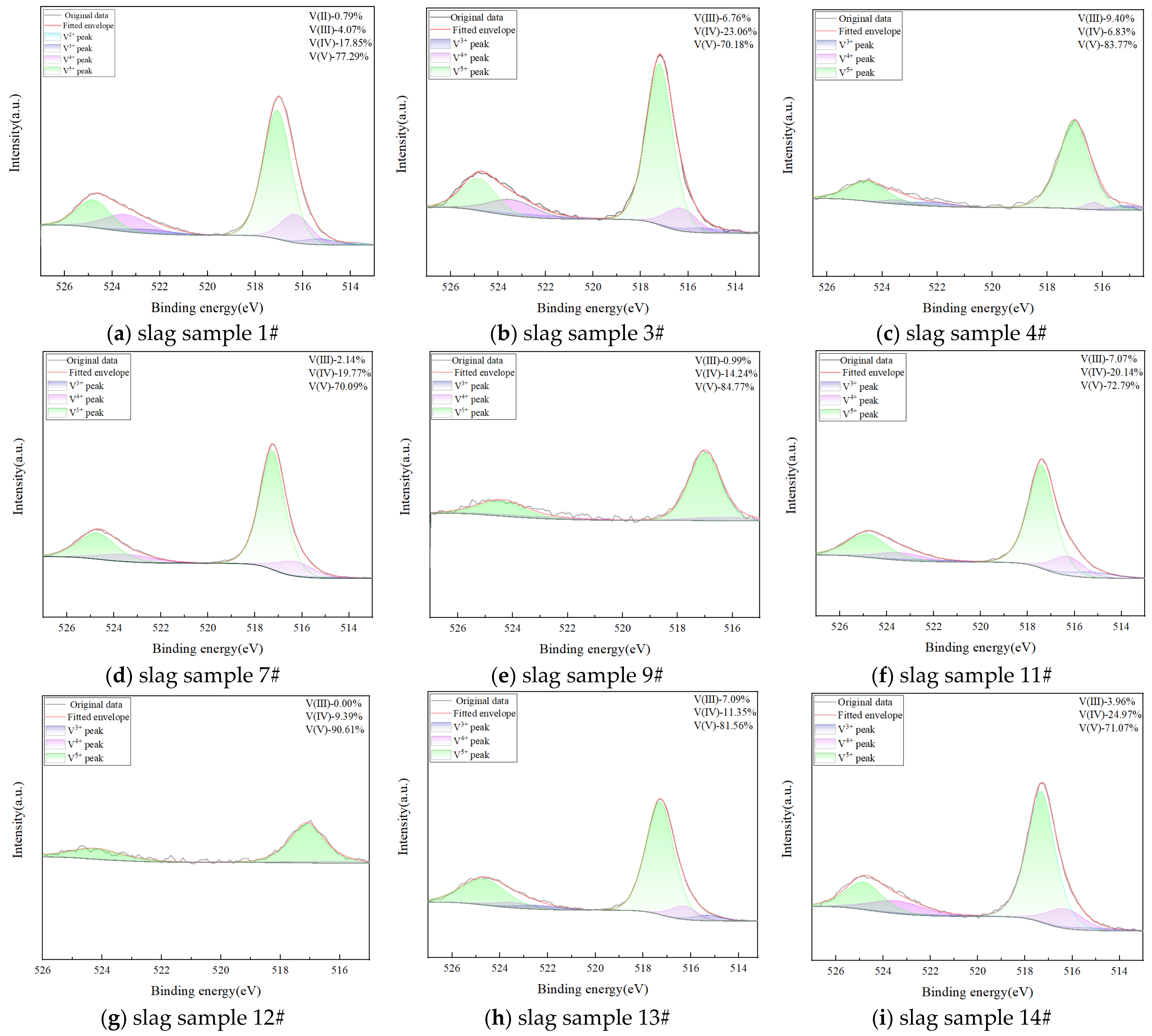

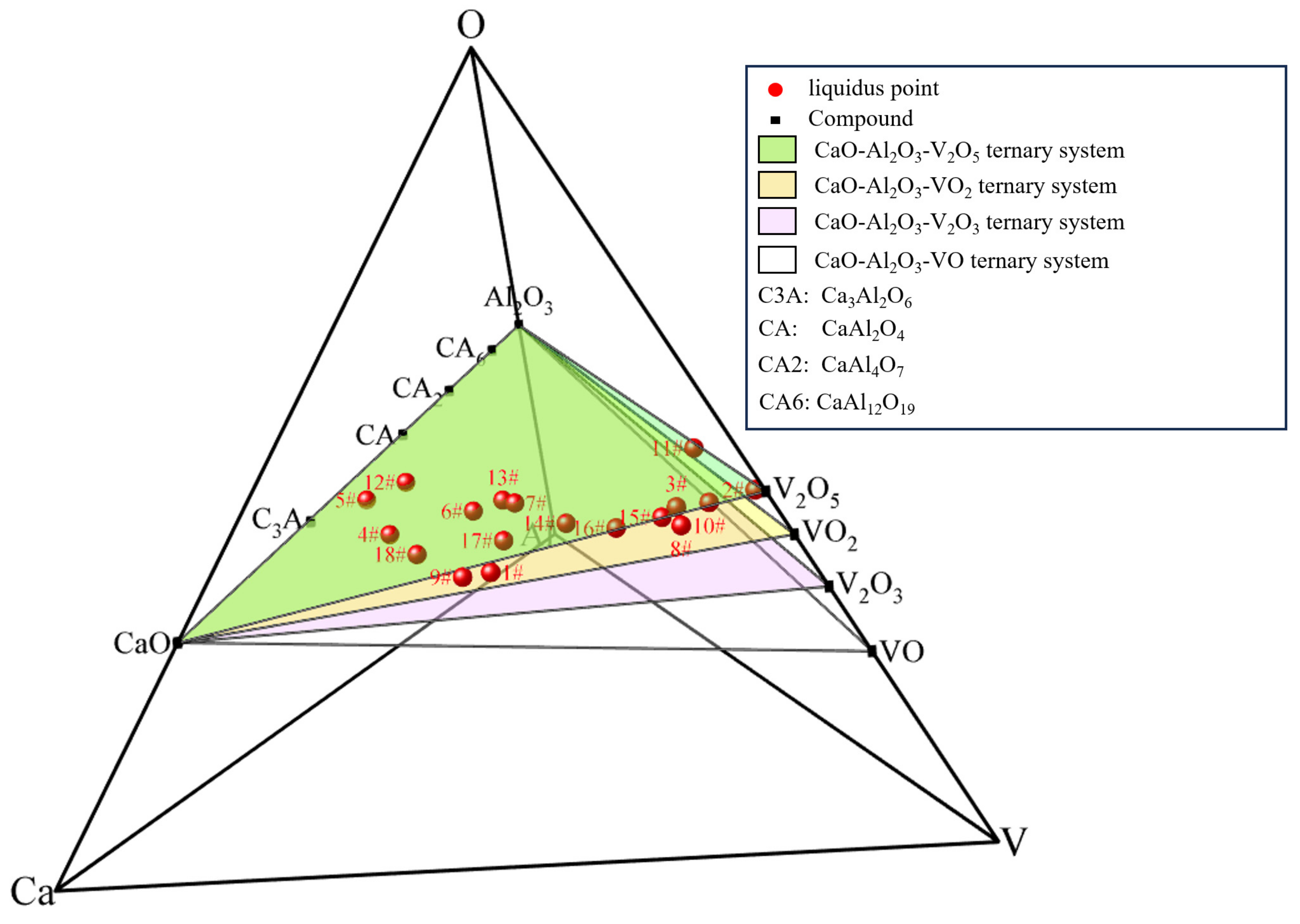
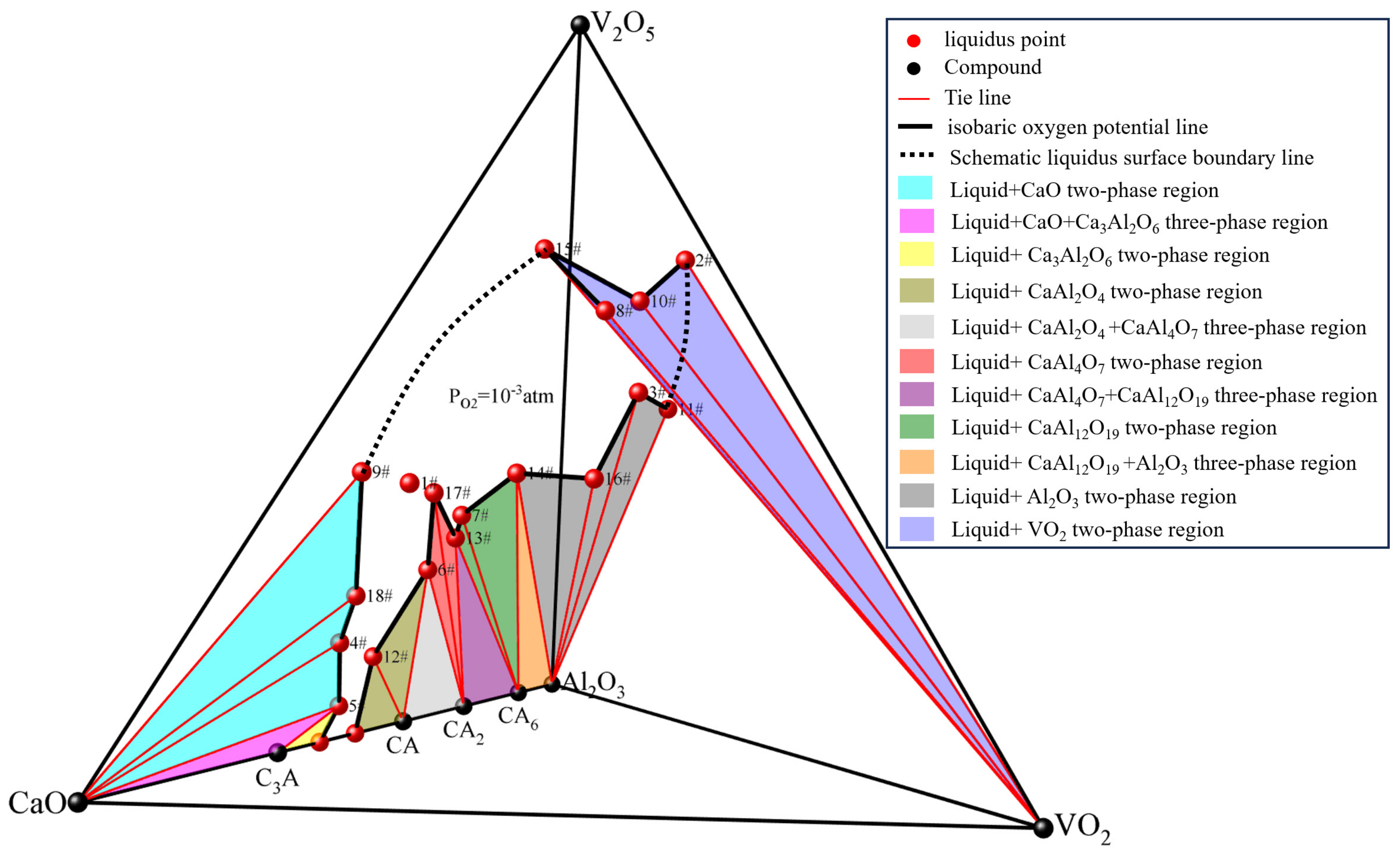
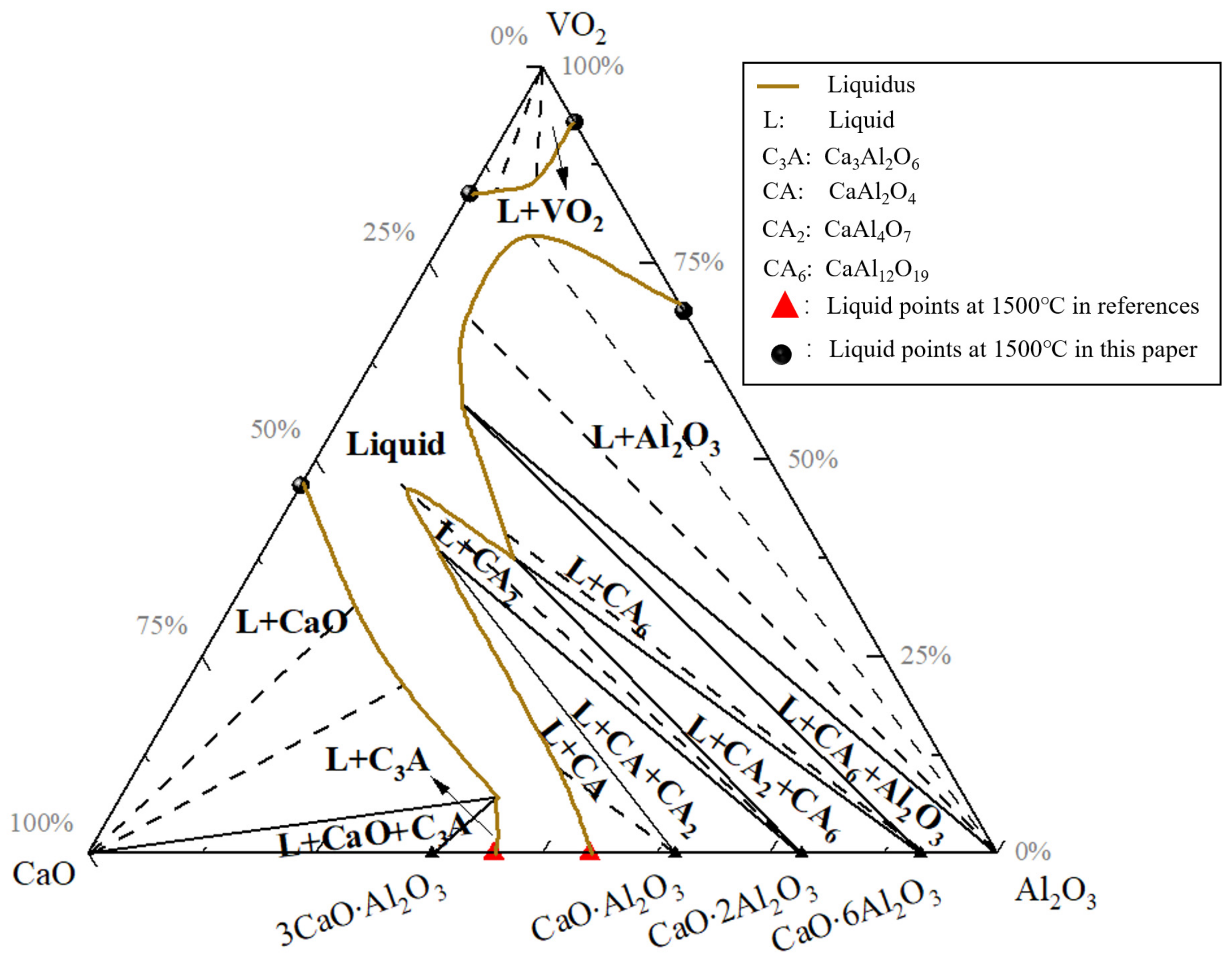

| No. | CaO | Al2O3 | V2O5 | No. | CaO | Al2O3 | V2O5 |
|---|---|---|---|---|---|---|---|
| 1# | 47.70 | - | 52.30 | 10# | 4.43 | 7.44 | 88.13 |
| 2# | - | 7.75 | 92.25 | 11# | - | 52.25 | 47.75 |
| 3# | 4.23 | 58.90 | 36.87 | 12# | 26.41 | 69.10 | 4.49 |
| 4# | 65.96 | 21.99 | 12.05 | 13# | 12.54 | 81.01 | 6.45 |
| 5# | 49.36 | 48.99 | 1.65 | 14# | 3.34 | 92.99 | 3.67 |
| 6# | 16.82 | 76.47 | 6.71 | 15# | 6.26 | 2.19 | 91.55 |
| 7# | 7.00 | 86.85 | 6.15 | 16# | 10.52 | 55.64 | 33.84 |
| 8# | 9.20 | - | 90.80 | 17# | 26.77 | 47.62 | 25.61 |
| 9# | 78.49 | - | 21.51 | 18# | 68.40 | 11.99 | 19.61 |
| Oxidation State | Binding Energy of V2p3/2 (eV) | Std. DeV. (±eV) | Energy Difference between V2p1/2 and V2p3/2 (eV) | FWHM, V2p3/2 (eV) | FWHM, V2p1/2 (eV) |
|---|---|---|---|---|---|
| +2 | 513.67 | 0.2 | 7.33~7.35 | 2.0~2.3 | 2.6~3.4 |
| +3 | 515.30 | 0.2 | 7.33~7.35 | 2.7~4.0 | 3.1~4.7 |
| +4 | 516.30 | 0.2 | 7.33~7.35 | 2.2~3.2 | 3.1~3.7 |
| +5 | 517.18 | 0.6 | 7.33~7.48 | 1.0~1.5 | 2.6 |
| No. | Phase | Ca | Al | V | O | No. | Phase | Ca | Al | V | O |
|---|---|---|---|---|---|---|---|---|---|---|---|
| 1# | Glass | 40.58 | - | 26.44 | 32.98 | 10# | Glass | 6.97 | 2.88 | 43.77 | 46.38 |
| 2# | Glass | - | 2.80 | 42.93 | 54.27 | VO2 | - | 1.50 | 49.46 | 49.04 | |
| VO2 | - | - | 49.57 | 50.43 | 11# | Glass | - | 15.74 | 40.60 | 43.66 | |
| 3# | Glass | 11.02 | 4.13 | 40.42 | 44.43 | Al2O3 | - | 48.13 | 5.82 | 46.05 | |
| Al2O3 | - | 49.06 | 4.56 | 46.38 | 12# | Glass | 39.30 | 21.09 | 6.69 | 32.92 | |
| 4# | Glass | 47.84 | 11.55 | 11.06 | 29.55 | CaAl2O4 | 27.97 | 32.70 | 39.33 | ||
| CaO | 61.69 | 2.34 | 2.21 | 33.76 | 13# | Glass | 30.10 | 12.84 | 20.39 | 36.67 | |
| 5# | Glass | 42.34 | 17.94 | 3.69 | 36.03 | CaAl4O7 | 17.44 | 41.20 | - | 41.37 | |
| CaO | 63.14 | 2.83 | - | 34.03 | CaAl12O19 | 6.84 | 45.13 | - | 48.03 | ||
| Ca3Al2O6 | 42.33 | 17.94 | 3.68 | 36.05 | 14# | Glass | 25.88 | 5.82 | 30.08 | 38.22 | |
| 6# | Glass | 33.79 | 11.79 | 17.50 | 36.92 | CaAl12O19 | 5.77 | 48.11 | - | 46.12 | |
| CaAl2O4 | 27.56 | 29.83 | 4.32 | 38.29 | Al2O3 | - | 42.17 | - | 57.83 | ||
| CaAl4O7 | 16.41 | 39.95 | - | 43.64 | 15# | Glass | 14.97 | 1.38 | 41.10 | 42.55 | |
| 7# | Glass | 28.82 | 12.46 | 19.70 | 39.02 | VO2 | 0.94 | 0.35 | 46.21 | 52.49 | |
| CaAl12O19 | - | 47.97 | - | 52.03 | 16# | Glass | 20.26 | 3.30 | 35.19 | 41.25 | |
| 8# | Glass | 13.45 | - | 43.00 | 43.55 | Al2O3 | 0.43 | 49.49 | 4.60 | 45.48 | |
| VO2 | - | - | 51.14 | 48.86 | 17# | Glass | 32.90 | 5.07 | 24.73 | 37.30 | |
| 9# | Glass | 42.20 | - | 22.79 | 35.01 | CaAl4O7 | 16.00 | 37.49 | - | 46.51 | |
| CaO | 49.54 | - | 2.04 | 48.42 | 18# | Glass | 43.80 | 6.14 | 15.32 | 34.74 | |
| CaO | 29.67 | 0.79 | 2.57 | 66.97 |
| NO. | V5+ | V4+ | V3+ |
|---|---|---|---|
| 1# | 77.29 | 17.85 | 4.07 |
| 3# | 70.18 | 23.06 | 6.76 |
| 4# | 83.77 | 6.83 | 9.40 |
| 7# | 78.09 | 19.77 | 2.14 |
| 9# | 84.77 | 14.24 | 0.99 |
| 11# | 72.79 | 20.14 | 7.07 |
| 12# | 90.61 | 9.39 | - |
| 13# | 81.56 | 11.35 | 7.09 |
| 14# | 71.07 | 24.97 | 3.96 |
| 15# | 66.56 | 32.57 | 0.87 |
| 16# | 64.52 | 27.17 | 8.31 |
| 17# | 81.27 | 12.82 | 5.91 |
| NO. | CaO | Al2O3 | V2O5 | VO2 | V2O3 | O/V |
|---|---|---|---|---|---|---|
| 1# | 46.79 | - | 42.43 | 8.94 | 1.84 | 2.37 |
| 2# | - | 6.57 | 73.67 | 16.04 | 3.72 | 2.32 |
| 3# | 12.41 | 8.78 | 57.14 | 17.13 | 4.54 | 2.37 |
| 4# | 53.80 | 24.54 | 18.56 | 1.38 | 1.72 | 2.38 |
| 5# | 51.24 | 40.99 | 6.13 | 1.33 | 0.31 | 2.42 |
| 6# | 39.08 | 25.70 | 27.77 | 6.05 | 1.40 | 2.33 |
| 7# | 32.45 | 24.48 | 34.36 | 7.93 | 0.78 | 2.45 |
| 8# | 15.21 | - | 66.86 | 14.55 | 3.38 | 2.37 |
| 9# | 51.26 | - | 41.91 | 6.42 | 0.40 | 2.34 |
| 10# | 7.84 | 6.14 | 67.83 | 14.77 | 3.43 | 2.43 |
| 11# | - | 29.70 | 52.76 | 13.31 | 4.22 | 2.28 |
| 12# | 43.20 | 43.79 | 11.88 | 1.12 | - | 2.38 |
| 13# | 33.49 | 26.97 | 32.99 | 4.19 | 2.36 | 2.36 |
| 14# | 29.12 | 12.34 | 42.84 | 13.73 | 1.97 | 2.36 |
| 15# | 16.62 | 2.89 | 71.24 | 8.48 | 0.77 | 2.36 |
| 16# | 23.34 | 7.23 | 46.59 | 17.89 | 4.95 | 2.36 |
| 17# | 40.08 | 10.82 | 40.79 | 5.87 | 2.44 | 2.36 |
| 18# | 53.40 | 14.11 | 25.62 | 5.58 | 1.29 | 2.36 |
Disclaimer/Publisher’s Note: The statements, opinions and data contained in all publications are solely those of the individual author(s) and contributor(s) and not of MDPI and/or the editor(s). MDPI and/or the editor(s) disclaim responsibility for any injury to people or property resulting from any ideas, methods, instructions or products referred to in the content. |
© 2024 by the authors. Licensee MDPI, Basel, Switzerland. This article is an open access article distributed under the terms and conditions of the Creative Commons Attribution (CC BY) license (https://creativecommons.org/licenses/by/4.0/).
Share and Cite
Liu, C.; Xie, X.; Qiu, J.; Li, W.; Huo, G. The Phase Diagram of a CaO-Al2O3-VOx Slag System under Argon Atmosphere at 1500 °C. Metals 2024, 14, 108. https://doi.org/10.3390/met14010108
Liu C, Xie X, Qiu J, Li W, Huo G. The Phase Diagram of a CaO-Al2O3-VOx Slag System under Argon Atmosphere at 1500 °C. Metals. 2024; 14(1):108. https://doi.org/10.3390/met14010108
Chicago/Turabian StyleLiu, Chengjun, Xiaoxiang Xie, Jiyu Qiu, Wenjie Li, and Guojie Huo. 2024. "The Phase Diagram of a CaO-Al2O3-VOx Slag System under Argon Atmosphere at 1500 °C" Metals 14, no. 1: 108. https://doi.org/10.3390/met14010108
APA StyleLiu, C., Xie, X., Qiu, J., Li, W., & Huo, G. (2024). The Phase Diagram of a CaO-Al2O3-VOx Slag System under Argon Atmosphere at 1500 °C. Metals, 14(1), 108. https://doi.org/10.3390/met14010108






